

|
Calcareous Flowers: Tests and Cross-Sections of Sea Urchin Spines by Richard L. Howey, Wyoming, USA |
For over 50 years, I have been fascinated with echinoderms and from time to time I would come across drawings or photographs in a zoology book of a cross-section of a sea urchin spine and marvel at the complexity and symmetry. However, only in the last few years, by means of the Internet, have I been able to locate a few slides of such sections at prices that I could afford. All of the examples I have acquired are 19th Century and I don’t know of any supply house that provides such slides made now. To me this is rather surprising. These sections are lovely objects, have an instructional value, and would certainly appeal to collectors.
It is certainly true that these sections are not easily produced as I know from personal experience having had less than satisfactory results from several attempts. However, with modern equipment and techniques, I would think that it should be reasonably straightforward for a professional laboratory in a biological supply house to produce such sections but, as I said, I have never come across any and, who knows, they might end up selling for more than the 19th Century slides.
Sea urchin spines are composed primarily of magnesium and calcium carbonates and in appearance and structure, they take on a variety of forms. In Strongylocentrotus droehbachiensis and S. purpuratus, the spines are green and purple respectively, smooth, abundant, pointed but not sharp, solid, but fenestrated, and generally considerably shorter than the diameter of the test or “shell”. Interestingly, another species of the same genus, S. franscicanus, has longer spines with a quite different structure. The spines are composed of rings of crystals stacked like a series of miniature crowns for the entire length of the spine.
This means that if you slide your fingers along the spine in one direction, they slide smoothly, but when you try to reverse direction, your fingers experience the resistance of the tiny points of the rings of crystals. The crystals are a reddish-purple and when properly illuminated reveal themselves to be translucent and appear almost as though they had an inner glow. This is a remarkable creature and is a common species along the Pacific coast of the U.S., but all of my attempts to acquire a few additional specimens, whether dried or preserved, have met with failure. None of the biological supply houses stock them, so if some kind soul out there knows a source where I might acquire a few specimens of these, I would very much appreciate the information.
Now imagine trying to prepare a cross-section of such a spine that will end up being thin enough to be observed by transmitted light with a compound microscope. The crystals are quite brittle and so break rather easily when one is trying to grind a section, even though the overall spine is quite strong. So, producing such sections of these kinds of spine is a task for someone with extraordinary patience or else a very cleverly contrived robot.
There is a group of largely tropical sea urchins which are of special interest here. They have odd spines which contain a rather potent toxin and can cause painful wounds to the unwary human who steps on one. At the tip of the spine is a small bulbous projection with glands containing the toxin. Some species also have pedicellariae with glands containing toxins. Pedicellariae deserve an entire article to themselves. Essentially they are pincer-like structures with 2 or 3 (occasionally more) “jaws”; some sit directly on the skin of the urchin while others are on tiny stalks which often have a calcareous rod running through them for support. These bizarre little structures attack larvae or debris to help keep the urchin clean. Diadema can have spines near a foot in length! Here, on the high plateau where I live at an altitude of 7,200 feet, such creatures are as rare as hen’s teeth and nobody seems interested in making them accessible to echinoidophiles (lovers of sea urchins).
Another remarkable tropical echinoid is Heterocentrotus mammilatus which apparently is quite abundant, since specimens show up on Ebay with some regularity. This is a very impressive urchin with “club” spines which show considerable variation in color.


These belong to the large group of urchins, the Echinometridae. Their spines can be bought in quantity and are often used in crafts. They have a rather chalky character and if you try cutting one with a jeweler’s saw, you will discover that they produce a fine, white powdery dust which is bad for both the mechanical parts and the optics of microscopes. So, do your sawing well away from your lab. One is easily misled into thinking that because of the size of these spines, they should be fairly easy to section. Not so! However, when they are well prepared, they are quite impressive.

The tests of echinoids have long been a source of curiosity and aesthetic appreciation. They are indeed a marvel of engineering and when one begins to investigate them in detail, their intricacy is stunning. There are several different groups of echinoids that sort roughly into the categories of regular and irregular. The “standard”, “regular” sea urchin test is a familiar and fascinating object with many variations in size and color, but the general form is fairly consistent.

The irregular echinoids are, however, quite a different story.
Imagine a medium-sized regular test made of cookie dough, put it in a press and flatten it so that it is less than an inch thick and more or less circular, and then further imagine that you have a flower-like, pennate punch which will make a pattern consisting of rows of tiny holes–and, voila! (or wal-la, as some of my students used to say)–you have a sand dollar.

Before someone soaked it in bleach to clean it up and make it all nice and white, it was covered with minute spines and had a rather dirty-brown color.
Now, imagine one a bit bigger and thicker with some notches in it and you have an “arrowhead” sand dollar.

Imagine again that you have some cookie dough, only this time a much bigger lump which you flatten somewhat less and this time you end of with a “pancake” sand dollar.

And then there is also the wonderful sea biscuit

and even “sea cookies” which are only about an inch in diameter and almost perfectly round.
It may occur to you to ask: Why all of the pastry names? My personal theory is that they were all named by very hungry, shipwrecked sailors.
In addition to the sand dollars, another interesting group of irregular echinoids is the “heart” urchins. These tests have a rather different principle of organization than either the regular urchins or the sand dollars. These are burrowers and their design, wherein the mouth and the anus are located on the ventral side reflects that fact. Regular urchins have their teeth on the ventral side, but the anus on the dorsal side, such that the whole feeding system seems upside down to us. They use their teeth (which are part of the incredible jaw apparatus know as Aristotle’s lantern) to scrape algae off the substrate or from piling and rocks or to feed on kelp.


As you can see from the second image, some species have long colorful spines which, under the microscope, one discovers are barbed. This is an interesting genus called Maretia.
The cross sections of the spines often look like marvelously crafted ancient shields. Here is one from a cidaroid urchin with projections all around the outer edge:
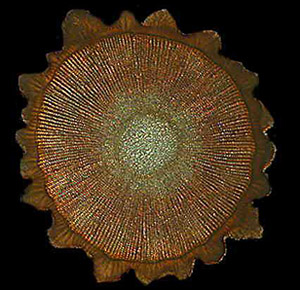
and here is one that looks as though it had been made of gold and bronze:

and yet another which could have been hammered out of silver:
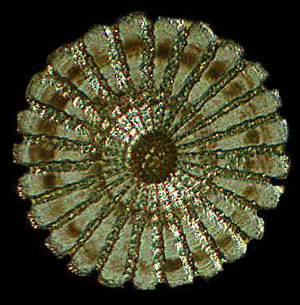
[NOTE: The spine sections were all photographed using polarized light.]
Some of the spines are very colorful and the variation in their shapes can be quite amazing as can be seen in the case of Psychocidaris:
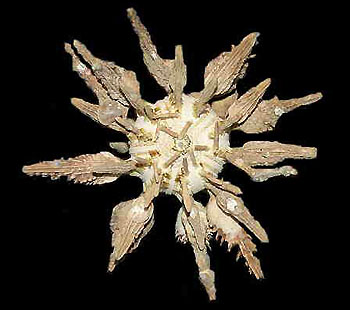
The real puzzle, however, is why the tests themselves, hidden completely from view, are so colorful. I will present a few examples here for you to wonder about.
A cidaroid urchin of the genus Stereocidaris grandis
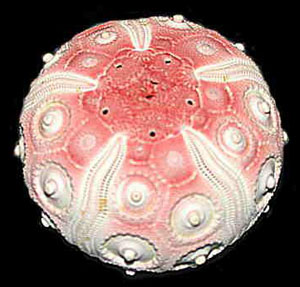
A small deep sea genus with a striking pattern: Coelopleurus interruptus*. This was dredged off the coast of New Caledonia from a depth of 1000 feet. (*Editor's note: Now C. exquisitus, with thanks to W. Clarenbach for pointing this out.)
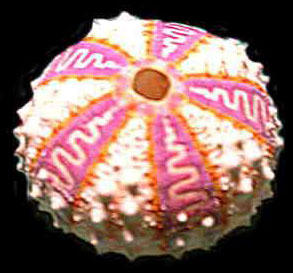
A “mushroom” urchin, Toxopneustes pileolus, with delicate coloration and lovely patterns:

Over hundreds of millions of years, nature has experimented on this planet with countless variations and adaptations and only a relatively small percentage have survived. Given the basic building blocks of the universe, the number of possible combinations is virtually infinite—more than enough to keep even the most curious of us occupied for a lifetime. When someone asks me: “But what’s the purpose of all of this?” My answer is: “To keep us puzzled.”
All comments to the author Richard Howey are welcomed.
Microscopy
UK Front Page
Micscape
Magazine
Article
Library
Please report any Web problems or offer general comments to the Micscape Editor.
Micscape is the on-line monthly magazine of the Microscopy UK website at Microscopy-UK